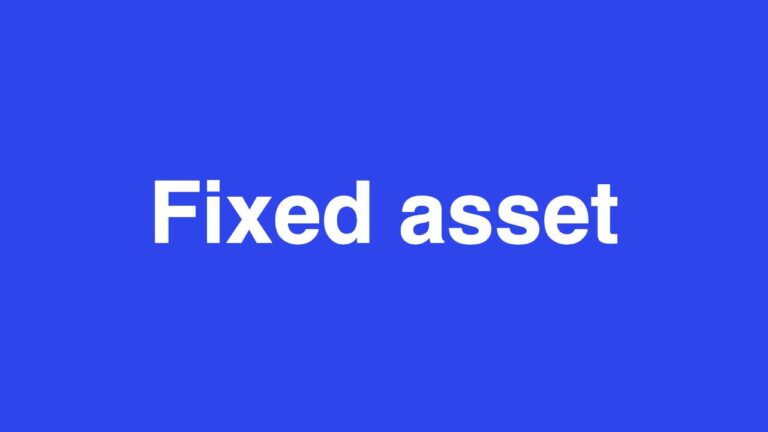Fixed asset: meaning, categories, characteristics and more

What are fixed assets?
Fixed assets are tangible or physical assets that are acquired by a business to use in its operations for a long period of time, typically over a year. These assets are considered essential to a business’s operations and are not meant for resale. Examples of fixed assets include property, plant, and equipment, such as land, buildings, machinery, and vehicles.
Fixed assets are recorded on a company’s balance sheet as assets and are usually listed under a separate category called “property, plant, and equipment.” When a business acquires a fixed asset, the cost of the asset is recorded on the balance sheet as an asset, this cost gradually depreciates over the asset’s lifetime.
It’s important to note that fixed assets are different from current assets, which are assets that are expected to be converted into cash within a year or less. Examples of current assets include cash, accounts receivable, and inventory.
The Importance of fixed assets in business operations
Fixed assets are critical to a business’s operations as they help in the production of goods and services. For instance, a manufacturing company may use machinery to produce goods, while a transportation company may use vehicles to transport goods and people. These assets are essential to the functioning of the business, and without them, the business may not be able to operate efficiently.
Fixed assets also help to increase the value of a business. As fixed assets are recorded on the balance sheet as assets, they can increase the net worth of the business. This can be important when seeking financing or when considering selling the business.
Furthermore, fixed assets provide a long-term return on investment for a business. While the initial cost of acquiring fixed assets can be significant, these assets can provide a return on investment over many years. For example, a business that invests in a building can use it for many years and may be able to generate revenue from it through renting or leasing.
However, it’s important to note that fixed assets also require ongoing maintenance and repairs, which can be costly. Additionally, the value of fixed assets can decline over time due to wear and tear, technological advancements, or changes in market conditions. Therefore, it’s important for businesses to carefully consider the acquisition of fixed assets and to develop strategies for managing and maintaining them effectively.
The three categories of fixed assets
1. Tangible assets
A tangible capital asset is a physical asset owned. That is, it can be used in the production of market goods and services or can be rented out to third parties.
In this category, we find land, buildings, equipment and industrial tools, office equipment, transport equipment etc.
2. Intangible assets
An intangible asset is a business asset that is neither physical nor monetary (otherwise it would be a financial asset).
In this category, we find establishment costs, research and development costs, patents, licenses and trademarks, software, websites and goodwill.
3. Financial fixed assets
Financial fixed assets correspond to the monetary assets of the company. They are accounted for in class 26 and 27 accounts.
Financial fixed assets include equity investments and any related receivables, fixed securities, loans granted by the company, deposits and guarantees.
Minimum amount of a fixed asset
The minimum amount divers by jurisdiction or country. The European Union tax law sets fixed assets at €500 ($544) the amount to which a company is obliged to amortize an investment and therefore to immobilize it, there is no minimum amount to consider an investment as an asset. As an exception, goods of low value, less than €500 ($544), can nevertheless be considered as consumed during the year and therefore recorded in expenses. It should be noted that, unlike a fixed asset which is deducted from taxes over several years according to the calculation of depreciation, a charge is deducted in full during the first accounting period.
In Nigeria, the Business Facilitation Act 2023 increases the minimum amount for the certificate of acceptance on fixed assets (CAFA) from ₦500, 000 to ₦5,000,000.
Characteristics of a fixed asset
A fixed asset is an asset that has the following four characteristics:
- It must be measurable (we can reliably determine the cost of the asset);
- It must allow the creation of economic benefits for the company (either by providing income or by reducing costs);
- It must be identifiable (the asset can be isolated, separated, rented, or sold in its individuality);
- And it must be controllable by the company (it is the company that determines the advantages that this asset provides and how to benefit from it).
- In the balance sheet, fixed assets are separated into three categories: tangible fixed assets, intangible fixed assets and financial fixed assets.
Accounting for fixed assets
Maintaining accurate records of fixed assets is critical for businesses to effectively manage and utilize these assets. It’s important to keep track of the original cost of the asset, the date it was acquired, any subsequent improvements made to the asset, and the estimated useful life of the asset. This information is necessary for calculating depreciation and ensuring that the asset is being utilized effectively.
One of the key tips for maintaining accurate records of fixed assets is to conduct regular physical inventories. This involves physically verifying the existence and condition of each fixed asset and updating the records accordingly. This process can help identify any missing or damaged assets and ensure that the records are up-to-date.
Another important tip is to use an asset management software system to track fixed assets. This can help automate the process of tracking and maintaining records of fixed assets, making it easier to manage large volumes of assets.
Finally, businesses should ensure that they have a clear and consistent policy for disposing of fixed assets. This can help prevent losses due to theft, damage, or obsolescence, and ensure that assets are being disposed of in an appropriate and ethical manner. By following these tips and maintaining accurate records of fixed assets, businesses can effectively manage and utilize these critical assets for long-term success.
Conclusion
Fixed assets are essential to the operations and success of many businesses. They provide a long-term return on investment and increase the value of the business. It’s important for businesses to carefully consider the acquisition of fixed assets and to develop strategies for managing and maintaining them effectively.
Accurately accounting for fixed assets is also crucial for businesses to effectively manage and utilize these assets.
Don't miss a thing. Follow us on Telegram and Follow us on WhatsApp. If you love videos then also Subscribe to our YouTube Channel. We are on Twitter as MakeMoneyDotNG.





